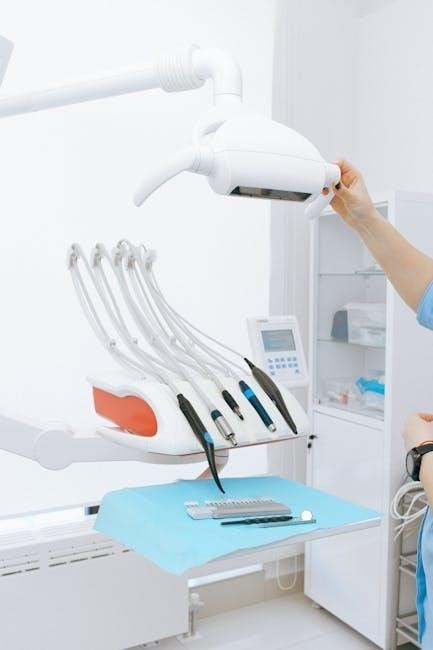
A dental consent form is a legal document outlining treatment details, risks, and benefits. It ensures patients are informed and agree to procedures, protecting both parties legally.
1.1 What is a Dental Consent Form?
A dental consent form is a written agreement between a patient and dentist, outlining the details of a proposed treatment. It ensures the patient is fully informed and agrees to the procedure. The form typically includes the nature of the treatment, potential risks, benefits, and alternatives. It also acknowledges the patient’s understanding and willingness to proceed. This document serves as legal protection for both parties, confirming that the patient has given informed consent. Dental consent forms are used for various treatments, from routine cleanings to complex surgeries, ensuring transparency and compliance with ethical standards.

Importance of Informed Consent in Dentistry
Informed consent ensures patients understand treatment risks and benefits, fostering trust and legal protection for dentists. It confirms patients agree to procedures knowingly and voluntarily.
2.1 Legal and Ethical Considerations
Legal considerations require dental consent forms to protect practitioners from liability, ensuring treatments are authorized. Ethically, informed consent respects patient autonomy, enabling decisions based on full disclosure of risks, benefits, and alternatives. This dual focus ensures transparency and accountability, fostering trust between patients and dental professionals while adhering to regulatory standards. Proper documentation safeguards both parties, preventing misunderstandings and potential disputes. Compliance with local laws and professional guidelines is essential to maintain ethical practices and legal protection in dentistry.

Key Elements of a Dental Consent Form
A dental consent form includes procedure details, risks, benefits, alternatives, and patient acknowledgment. It ensures clarity, protecting both patient and practitioner by confirming informed agreement and understanding.
3.1 Components of a Standard Form
A standard dental consent form includes detailed procedure descriptions, potential risks and benefits, treatment alternatives, and patient acknowledgment. It also outlines the patient’s medical history and any known allergies. The form must be signed and dated by both the patient and the dentist, confirming mutual understanding. Additionally, it may include sections for witnessing signatures and specific clauses addressing photography or treatment termination. These components ensure transparency, protecting both parties and confirming informed consent. The form is tailored to the procedure, such as root canal therapy or dental implant surgery, ensuring relevance and comprehensiveness.
Types of Dental Treatment Consent Forms
Dental consent forms vary, including general and specialized types like orthodontic treatment packages or implant surgery consent forms, tailored to specific procedures and patient needs.
4.1 General and Specialized Forms
Dental consent forms are categorized into general and specialized types. General forms cover routine procedures like cleanings and fillings, while specialized forms address complex treatments such as root canal therapy, dental implants, or orthodontic packages. Specialized forms provide detailed explanations of risks, benefits, and alternatives, ensuring patients fully understand the procedure. Both types are customizable using templates, allowing dentists to tailor content to specific treatments. These forms are essential for legal protection and patient trust, ensuring clear communication and informed decision-making. Digital tools further streamline the process, making it efficient and accessible for dental practices.
Creating and Customizing Consent Forms
Customizing dental consent forms involves tailoring content to specific treatments using templates. Digital tools simplify the process, ensuring clarity and compliance with legal requirements while maintaining patient understanding.
5.1 Using Templates and Digital Tools
Utilizing templates and digital tools simplifies the creation of dental consent forms. Pre-designed templates provide a framework, reducing redundancy and ensuring consistency. Digital platforms offer customizable options, allowing dentists to tailor forms to specific treatments. Tools like consent management software enhance efficiency, enabling electronic signatures and secure storage. These solutions also ensure compliance with legal standards, making the process streamlined and patient-friendly. By leveraging technology, dental practices can maintain accurate records and improve communication, fostering trust and transparency in patient care.

Legal Implications and Compliance
Dental consent forms ensure legal protection for both patients and dentists by documenting informed consent and adherence to regulatory standards, minimizing liability risks.
6.1 Understanding Regulations
Regulations governing dental consent forms ensure transparency and accountability, protecting both patients and practitioners. These laws mandate clear communication of treatment risks, benefits, and alternatives. Compliance with standards like GDPR and HIPAA is crucial to maintain patient privacy. Understanding these regulations helps dentists avoid legal disputes and ensures ethical practice. Proper documentation, including signed consent forms, is essential for audit trails. Templates and digital tools simplify compliance, reducing errors. Staying updated on regulatory changes ensures adherence to current legal requirements, fostering trust and professionalism in dental care.

Best Practices for Dentists
Dentists should ensure clear communication, using consent form templates to outline risks, benefits, and alternatives. Involving patients in decisions fosters trust and informed choices, ensuring legal and ethical compliance.
7.1 Effective Communication
Effective communication is crucial when discussing dental consent forms with patients. Dentists should explain procedures clearly, ensuring patients understand risks, benefits, and alternatives. Active listening and addressing concerns foster trust. Using plain language, avoiding jargon, and providing written materials like consent form templates help patients make informed decisions. This ethical approach ensures compliance with legal standards and builds a strong patient-provider relationship. Clear communication also reduces misunderstandings, ensuring patients feel confident in their care decisions. Regular updates throughout treatment keep patients informed and engaged in their dental care journey.

Digital Solutions for Consent Forms
Digital platforms streamline consent form processes, offering templates and tools for easy customization. They enhance efficiency, reduce errors, and ensure compliance, benefiting both dentists and patients.
8.1 Streamlining the Process
Digital solutions simplify consent form management through electronic signatures, pre-built templates, and automated workflows. These tools reduce paperwork, minimize errors, and save time, enabling dentists to focus on patient care. Online platforms allow easy customization of forms, ensuring compliance with legal standards. Patients can access and sign forms remotely, improving convenience and streamlining the process. Digital storage options also enhance organization and quick retrieval of records. These solutions integrate seamlessly with practice management systems, further enhancing efficiency and reducing administrative burdens for dental clinics.

Patient’s Role and Responsibilities
Patient must acknowledge risks, ask questions, and provide accurate medical history. Understanding the form ensures informed decisions, fostering trust and accountability in dental care.
9.1 Understanding and Signing the Form
Patients must thoroughly understand the dental consent form before signing. It outlines procedure risks, benefits, and alternatives, ensuring informed decisions. They should ask questions to clarify doubts. Providing accurate medical history is crucial for safe treatment. Signing confirms agreement and acknowledgment of potential outcomes. This step protects both patient and dentist legally. Clear communication is essential to avoid misunderstandings. The form serves as a mutual agreement, fostering trust and accountability in dental care. Patients should retain a copy for their records.
Dental consent forms are essential for legal protection and informed patient decisions. They outline risks, benefits, and alternatives, ensuring clear communication and trust between patients and dentists.
10.1 Summary and Final Thoughts
Dental consent forms are crucial for ensuring informed patient decisions and legal protection. They clearly outline treatment risks, benefits, and alternatives, fostering trust between patients and dentists. Digital solutions and customizable templates simplify the process, enhancing efficiency for clinics. These forms protect both parties by providing a clear understanding of procedures. Their importance lies in promoting transparency, accountability, and patient autonomy, making them indispensable in modern dental practice. By streamlining consent processes, they contribute to better patient care and stronger dentist-patient relationships.